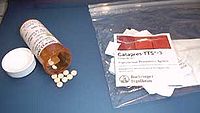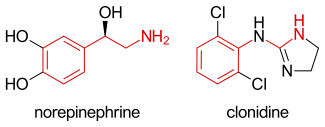Clonidine
Clonidine, sold under the brand name Catapres among others, is an α2A-adrenergic receptor agonist[12] medication used to treat high blood pressure, ADHD, drug withdrawal (e.g., alcohol, opioids, or nicotine), menopausal flushing, diarrhea, spasticity, and certain pain conditions.
[13] Common side effects include dry mouth, dizziness, headaches, hypotension, and sleepiness.
[14] If rapidly stopped, withdrawal effects may occur, such as a dangerous rise in blood pressure.
[14] Clonidine lowers blood pressure by stimulating α2-adrenergic receptors in the brain, which results in relaxation of many arteries.
[18][19] Clonidine is used to treat high blood pressure, attention deficit hyperactivity disorder (ADHD), drug withdrawal (alcohol, opioids, or nicotine), menopausal flushing, diarrhea, and certain pain conditions.
[20] Clonidine works by slowing the pulse rate and exerts a reduction of serum concentrations of renin, aldosterone, and catecholamines.
[24][25][26] While not as effective as methylphenidate in treating ADHD, clonidine does offer some benefit;[24] it can also be useful in combination with stimulant medications.
[28][29] Clonidine has been used to reduce sleep disturbances in ADHD, including to help offset stimulant-associated insomnia.
[35] Clonidine may be used to ease drug withdrawal symptoms associated with abruptly stopping the long-term use of opioids, alcohol, benzodiazepines, and nicotine.
[36] It can alleviate opioid withdrawal symptoms by reducing the sympathetic nervous system response such as tachycardia and hypertension, hyperhidrosis (excessive sweating), hot and cold flashes, and akathisia.
Clonidine may also reduce severity of neonatal abstinence syndrome in infants born to mothers that are using certain drugs, particularly opioids.
[44] The reduction in circulating norepinephrine by clonidine was used in the past as an investigatory test for phaeochromocytoma, which is a catecholamine-synthesizing tumor, usually found in the adrenal medulla.
[63] Clonidine has also had some success in clinical trials for helping to remove or ameliorate the symptoms of hallucinogen persisting perception disorder (HPPD).
[65] Light-activated derivatives of clonidine (adrenoswitches) have been developed for research purposes and shown to control pupillary reflex with light in blind mice by topical application.
[66] It is classified by the TGA of Australia as pregnancy category B3, which means that it has shown some detrimental effects on fetal development in animal studies, although the relevance of this to human beings is unknown.
[69] The principal adverse effects of clonidine are sedation, dry mouth, and hypotension (low blood pressure).
Thus, clonidine's agonism on α2A adrenergic receptors in the PFC inhibits the action of downstream neurons by preventing the secretion of norepinephrine.
[6] Following a 0.3 mg oral dose, a small study of five patients by Dollery et al. (1976) found half-lives ranging between 6.3 and 23.4 hours (mean 12.7).
[94] A similar N=5 study by Davies et al. (1977) found a narrower range of half-lives, between 6.7 and 13 hours (mean 8.6),[4] while an N=8 study by Keraäen et al. that included younger patients found a somewhat shorter mean half-life of 7.5 hours.

